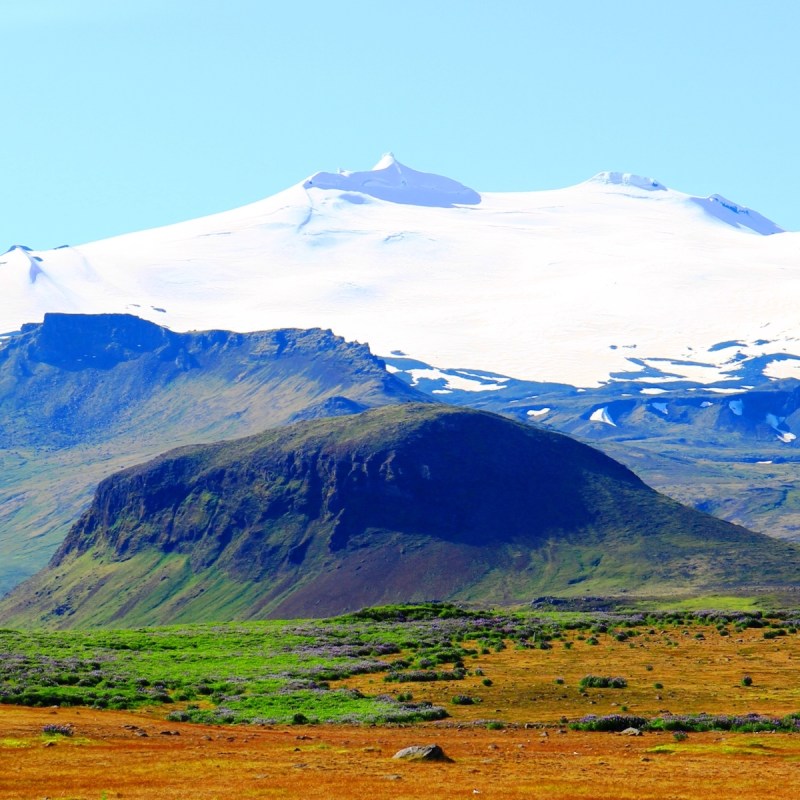
Iceland’s nickname is the “Land of Fire and Ice,” and you understand why when you visit. It’s one of the few places in the world where you can see volcanos, glaciers, snow-capped mountains, and geysers in an area roughly the size of Kentucky.
Videos by TravelAwaits
You won’t have trouble finding exciting things to do in Iceland, regardless of your interests. These are some of my most vivid memories — and the ones I tell people about. Many were unexpected “gems” that left us amazed and some we found purely by chance.

1. Hallgrímskirkja
A Truly Icelandic Church
The Hallgrímskirkja is the largest church in Iceland and reigns over downtown Reykjavík with its 246-foot steeple. Gudjon Samuelsson, Iceland’s chief architect, incorporated geographical and cultural elements of Iceland into the design to create a national monument for Iceland.
The columns on the sides of the tower represent volcanic basalt and the ones at the base resemble the Svartifoss, a waterfall in Vatnajökull National Park. The cylindrical shape of the nave is said to represent Viking war helmets.

The statue of Leif Eriksson in front of the Hallgrímskirkja was a gift from the United States to Iceland as a tribute to the 1,000th anniversary of the Icelandic parliament.
Pro Tip: Take the elevator to the observation platform at the top of the tower. It costs approximately $7.50, and the panoramic view of Reykjavík is worth it.

2. The Perlan
Science And Scenery In The Round
The Perlan (Pearl) is a high-tech nature center housed in a rotating glass dome. It’s located near downtown Reykjavík and is built on six large water tanks that store the city’s hot water supply.
Walk through a 100-yard-long ice tunnel, experience a volcano, and see a replica of the Látrabjarg, a bird cliff in the Westfjords of Iceland. And don’t leave without visiting the planetarium. One of the highlights is Áróra, an interactive film that features some of Iceland’s most prominent photographers, writers, and musicians. Guests are encouraged to participate in the show.

3. The Penis Museum
How many people can claim they’ve been to a museum dedicated to penises? There’s one in downtown Reykjavík, and the locals will make sure you know about it by casually working it into conversations and while giving directions. That’s how we learned about it.
The Icelandic Phallological Museum displays over 300 penises and penile parts from more than 100 mammal species, including a horse, a bull, a dolphin, and whales. Sigurður Hjartarson, the founder, collected organs of Icelandic animals from sources countrywide, including specimens from the 67-inch front tip of a blue whale penis to the 0.08-inch penile bone of a hamster, which can only be seen with a magnifying glass.
He claims the collection includes the penises of elves and trolls, but we can’t see them because, according to Icelandic folklore, elves and trolls are invisible.
Pro Tip: Visit the small souvenir shop behind the museum. There are some interesting educational materials, and the gag items are good for a laugh.

4. Heimaey Island
Pompeii Of The North
Heimaey Island is called “Pompeii of the North” because, like Pompeii, its residents were caught by surprise when a volcano erupted without warning.
In January 1973, the Eldfell, a newly formed volcano, rained 200 million tons of ash and lava over several days. Fissures almost a mile long cut through buildings and destroyed over 400 homes.
All 5,300 residents were safely evacuated. To limit the spread of lava, U.S. troops and Icelandic rescue services pumped seawater over it to make it freeze, saving the harbor from being closed.
When archaeologists excavated houses near the volcano in 2006, they found many were exactly as residents had left them. One lady found a partially finished sweater she had been knitting for her son. By then, the son now had children of his own. So, she completed the sweater for her grandson.
Pro Tip: If you dig a hole in the lava fields near the Eldfell, the soil is still warm. You can feel the heat in some places by sitting on the ground.
The easiest way to visit Heimaey Island is to take the ferry from Herjólfur, about 2 hours from Reykjavík. There’s a large lot, and parking is free as of this writing.

5. The Golden Circle
The Golden Circle refers to an area east of Reykjavík with three popular attractions — the Gullfoss (Golden Waterfall), the Strokkur and Geysir Geysers, and Thingvellir National Park.
Gullfoss
Iceland has no shortage of waterfalls, but most people agree that the Gullfoss is one of its most spectacular. Experts agree, too — it was named one of the world’s top 10 waterfalls by world-of-waterfalls.com.
The Gullfoss is in the Hvita (White) River and is fed by Langjokull, Iceland’s second-largest glacier. It’s called the Golden Waterfall because the water looks golden-brown on sunny days since glacial water contains a lot of sediment.

Strokkur And Geysir Geysers
Geothermal water heats 90 percent of all Icelandic homes, virtually eliminating the need for water heaters. You can see geothermal heating in action when you watch the bubbling, heated mud and steaming pools at the Geysir hot spring while waiting for the Strokkur Geyser to erupt.
The Geysir Geyser used to be active about 100 years ago, but it no longer erupts. The Strokkur Geyser erupts about every 6 to 10 minutes. So, have your camera ready to get the perfect shot.
Thingvellir National Park
Thingvellir National Park is a UNESCO-designated World Heritage Site and is also the birthplace of the Althing, Iceland’s parliament, founded in 930 A.D. It’s also one of the few places in the world where you can touch two tectonic plates.
The Eurasian and North American tectonic plates meet in a rift valley in Thingvellir National Park. Take a walk between two continents, or brave 35-degree-Fahrenheit water temperatures to SCUBA dive through the Silfra Fissure.
All these attractions are in the Haukadalur Valley about 33 miles east of Reykjavik. Follow the Ring Road east and turn onto Road 35. Follow that route, and you’ll reach the parking lot and visitor center.
Pro Tip: Book a Golden Circle Tour to see all these sites. Round-trip transportation is included along with a professional guide. Pickup is available at most Reykjavík hotels, guesthouses, and some bus stops.

6. Akureyri
Touch The Arctic Circle
Many people have been to places on or near the equator, but few have been close to the Arctic Circle. Visit Akureyri, Iceland’s “Capital of the North,” and you’ll be a stone’s throw away.
Akureyri is the second-largest city in Iceland, but with a population of around 20,000, it has a small-town atmosphere. It’s situated at the head of Eyjafjörður, Iceland’s longest fjord, and is surrounded by snowcapped mountains and, in the summer, dotted with colorful flowers.
Lystigarðurinn
While in Akureyri, visit the Lystigarðurinn, the northernmost botanical garden in the world, to see every plant native to Iceland and high-latitude and high-altitude plants from elsewhere.

Akureyrarkirkja
The Akureyrarkirkja (Akureyri Church) presides over the small, walkable downtown area from its hilltop perch. Climb the 112 stairs to see the 3,200-pipe organ and the stained-glass window above the altar, which came from Coventry Cathedral in England. A suspended ship hanging from the ceiling is a Nordic tradition that honors those at sea.
Godafoss
The Godafoss (Waterfall of the Gods) is another of the country’s many magnificent waterfalls. The view from both sides of the Godafoss is spectacular. Although it’s a bit of a walk from one side to the other, the views are well worth it.
The Godafoss is about 30 miles from Akureyri. If you’re driving, it’s just off the Ring Road. Day tours are also available and include transportation and a local guide.
Akureyri is easy to reach if you’re driving the Icelandic Ring Road, the highway that circles the country, and there are flights from Keflavik Airport in Reykjavik.
Pro Tip: If you’re lucky enough to be in Akureyri on a sunny summer day, take a sweater and light jacket wherever you go because the weather can change suddenly.

7. The Snaefellsnes Peninsula
Walk In Jules Verne’s Footsteps
Snæfellsjökull Glacier is a 7,000-year-old stratovolcano located in Snæfellsjökull National Park on the Snaefellsnes Peninsula (Snow Mount’s Peninsula) in Western Iceland. The name may sound familiar if you’ve read Journey to the Center of the Earth by Jules Verne.
As the story goes, Professor Otto Lidenbrock believed volcanic tubes in the Snæfellsjökull led to the earth’s core. So, he set out on a subterranean expedition with his nephew and an Icelandic guide. Their trek began when they descended into the Snæfellsjökull and ended in Italy instead of the earth’s center.

You can see the glacier up close and experience your journey to the center of the earth by visiting two lava caves that were hidden from the outside world for thousands of years. Or just enjoy the view.
Arnarstapi, a small fishing village, was the Lidenbrock expedition’s last stop before they entered the netherworld and is a must-see. Extraordinary stone arches, basalt columns, and cliffs along the coast make this area one of the most beautiful places on the peninsula.
The otherworldly scenery will make you feel like you’re on a Lord of the Rings or Avatar set. The area is also a favorite for the hundreds of arctic terns that nest there.
To drive to the Snæfellsnes Peninsula, take the Ring Road (Route 1) north of Reykjavík and veer left onto Route 54, the main road on the peninsula. You can also book a tour through your hotel or a local agency.
